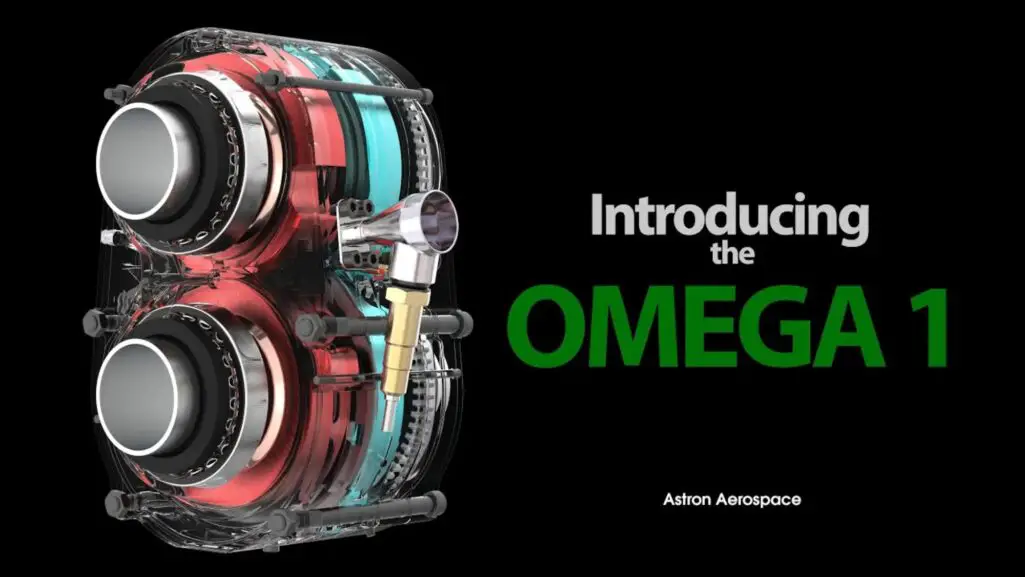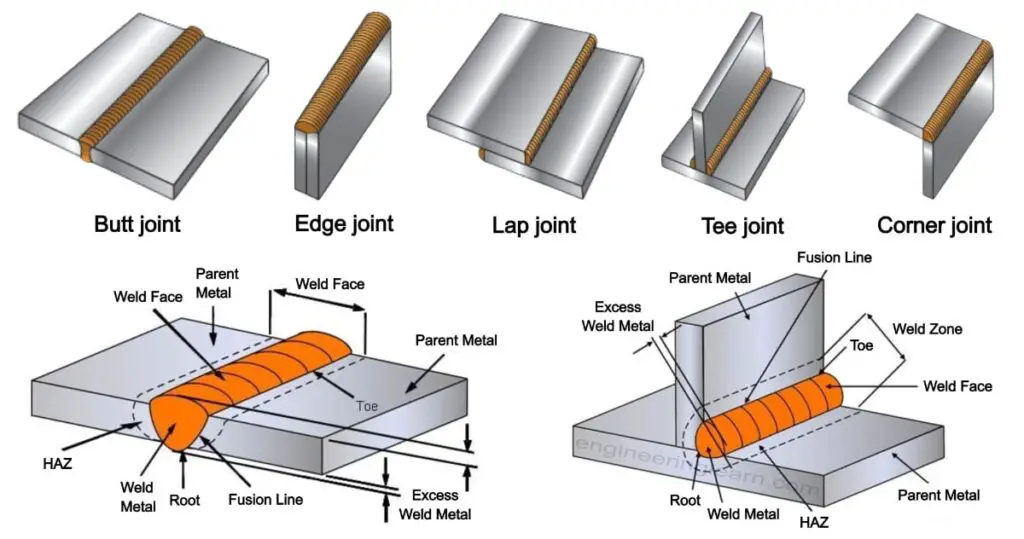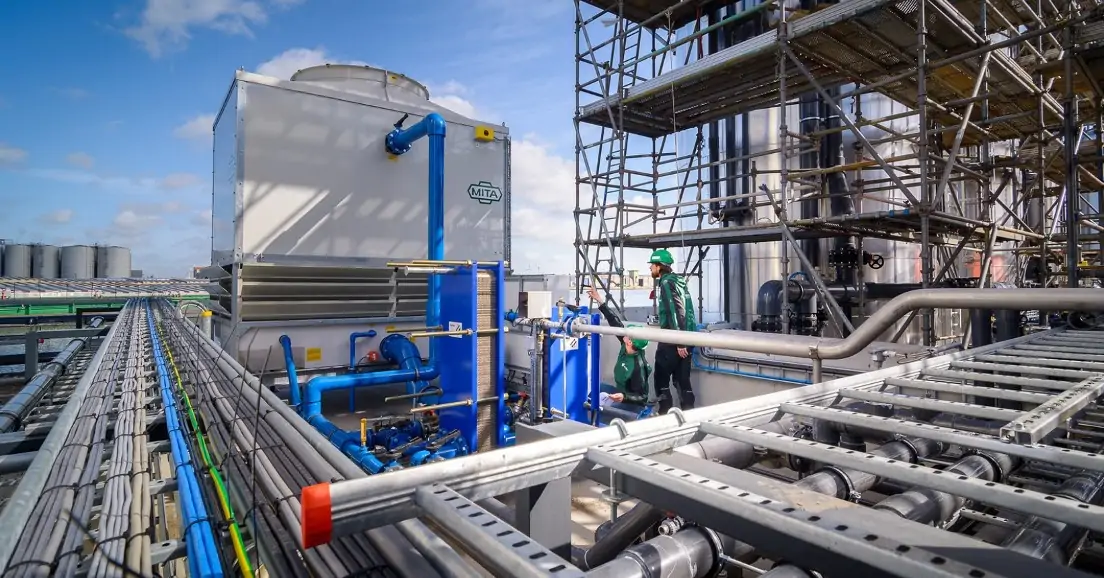What is a Steam Condenser?
A steam condenser is a heat exchanger that converts low-pressure steam to water in a closed vessel. The pressure within a steam condenser is kept below atmospheric pressure to maximize efficiency. It is commonly used to reduce the backpressure of the turbine end exhaust.
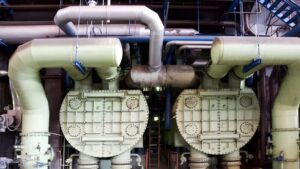 |
| Fig 1: Steam Condenser Source: dreamstime.com |
Why is Steam Condenser Used?
- The steam condenser is used to keep the exhaust end of the turbine at a low back pressure, increasing efficiency and lowering specific steam consumption.
- It is used to convert low-pressure steam to a liquid, such as water, which can then feed back into the boiler without further treatment.
- It also improves heat transfer efficiency by removing non-condensable gases from exhaust steam.
Uses of Steam Condenser in Power Plant
The steam condenser is the core of a thermal power plant’s functioning and a critical component of the water-steam cycle. The efficiency of a condenser has a direct impact on the plant’s power-generating capacity, which has an impact on operating expenses and the bottom line.
When steam is condensed into water in power plants, condensers serve as a heat-rejection engine. The conversion’s volume collapse results in a considerable pressure change, which creates a vacuum that draws steam through the turbine. Because the condenser’s heat transfer drives the water-steam cycle’s rear end, the efficiency of that heat exchange is critical to optimizing steam energy extraction.
How does a Steam Condenser Work?
The steam condenser absorbs exhaust steam from one end and contacts cooling water circulating within it from the cooling tower on the other. The low-pressure steam condenses and transforms into the water when it comes into touch with the cooling water.
It’s connected to both the air and condensate extraction pumps. With the help of a condensate extraction pump, the condensate is pumped to the hot well after steam condensation.
The air extraction pump draws air out of the condenser and creates a vacuum within it. The produced vacuum aids in the circulation of cooling water and the downward flow of condensate.
Steam Condenser Components
1- Condenser:
It is a sealed vessel used to condense the steam. During the condensation process, the low-pressure steam transfers its heat to the coolant (here, water from the cooling tower) and is transformed into water.
2- Condensate Extraction Pump:
A Condensate Extraction Pump transports condensate from the condenser to the hot well.
3- Hot Well:
A sump is a container that sits between the condenser and the boiler. The condensate pump collects the condensate from the condenser. The boiler gets its feed water from a hot well.
4- Boiler Feed Pump:
A pump transports feed water from the hot well to the steam boiler and is placed between the hot well and the boiler. The condensate pressure is raised above the boiler pressure to achieve this.
5- Air Extraction Pump:
A pump removes or extracts air from the steam condenser.
6- Cooling Tower:
It’s a tower with cold water circulating inside the condenser to cool the steam.
7- Cooling Water Pump:
A pump connects the condenser and cooling tower. Within the condenser, it circulates the coolant.
Types of Steam Condenser
The steam condenser is classified into two types:
1. Surface Condenser:
A surface condenser is used in thermal power plants to convert steam to water without contact with the coolant. As a result, without any water treatment, the removed condensate can be reused in the boiler. Shell and tube condensers are another name for this type of condenser.
A horizontal cylindrical vessel made of cast iron houses the surface condenser, filled with tubes through which cooling water flows. The perforated plates cut the condenser ends. The tubes are positioned inside these plates to prevent water from leaking into the condenser space’s center.
The exhaust steam enters at the top of the condenser and flows downward due to the suction of the air extraction pump. When steam comes into touch with cooling water tubes, it condenses, and heat is transferred via conduction and convection. A condensate extraction pump is located at the bottom of the condenser and aids in the extraction of condensed water.
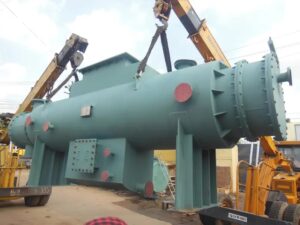 |
| Fig 2: Surface Condenser Source: coolingtowerindia.com |
The surface condenser is used on ships because it can only transport a limited amount of water to the boiler. It’s also widely used for land installations when good quality water is scarce.
Surface condensers are divided into four categories:
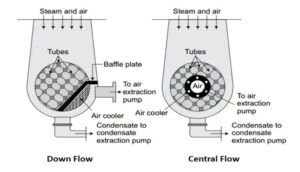 |
| Fig 3: Down Flow and Centre Flow Surface Condenser Source: mechanicalbooster.com |
i) Down flow Surface Condenser:
Due to gravity and air extraction pumps, steam enters at the top of the condenser and flows downhill over the tubes in a down-flow surface condenser. The condensate is collected at the bottom of the tank and then pushed out using a condensate extraction pump. The dry air extraction pump’s pipe is located near the bottom and is covered by baffle plates to prevent condensate from entering.
Because the steam in a down flow condenser flows perpendicular to the cooling water flow, it is also known as a cross-surface condenser.
ii) Central Flow Condenser:
Steam enters the top of the condenser and flows downward in the central flow condenser. The air extraction pump’s suction pipe is located in the tube nest’s middle.
The exhaust steam moves radially inside over the tubes towards the suction pipe being placed in the middle of the tube nest. The condensate is injected into the hot well after collecting at the bottom of the condenser.
iii) Evaporative Condenser:
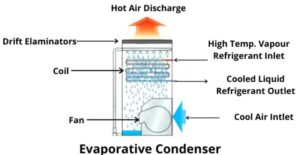 |
| Fig 4: Evaporative Condenser Source: engineersrail.com |
Steam enters an evaporative surface condenser from the top through tubes onto which a cool water film falls. A handful of nozzles are mounted at the top of the condenser to spray cooling water.
Air is created at the same time to circulate across the aqueous film. Some of the cooling water evaporates as the air passes over the water film.
The steam circulating within the tubes condenses due to this rapid evaporation, and The remaining cooling water is collected and reheated. It is warmed to the desired temperature by adding the needed amount of cold water.
iv) Regenerative Condenser:
The condensate is heated using the regenerative process in the regenerative surface condenser. Condensation forms as the exhaust steam from the turbine or engine pass past it. It raises its temperature and serves as boiler feed water.
2. Jet Condensers:
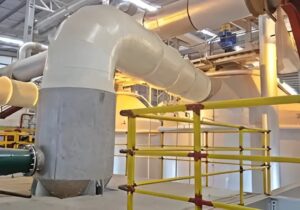 |
| Fig 5: Jet Condenser Source: hexonengineering.com |
A condenser in which the condensate is blended with the cooling water is a jet condenser. As a result, it’s also known as a mixing type condenser.
This condenser is sometimes utilized since it loses some condensate and demands a lot of electricity from the pump during the condensation process.
Because the condensate from a jet condenser contains salt, it cannot be used as boiler feed water. It can be utilized anywhere there is a sufficient supply of good quality water.
Jet condensers are divided into four categories:
i) Parallel Flow Condenser:
In a parallel flow jet condenser, the steam and cooling water flow in the same direction; both enter from the top of the condenser and exit after mixing from the bottom. The steam condenses as it comes into contact with cooled water.
The air extraction pump and the condensate extraction pump remove the condensate, cooling water, and air as it descends downward. The condensate pump transports the condensate to the hot well, while the excess water flows into the cooling water tank or pond via the overflow pipe.
 |
| Fig 6: Parallel Flow and Counter Flow Jet Condenser Source: mechanicalbooster.com |
ii) Counter Flow Condenser:
The steam enters at the bottom and the cooling water at the top in counter Flow. The steam rises and collides with the cooling water flowing downward. The falling water jet is captured in the trays and emerges in the second sequence of jets, where it meets the exhaust stream entering at the bottom.
The steam condenses as it interacts with the water. A vertical pipe transports the condensate and cooling water to the condensate pump. The pump then transports it to the hot well.
iii) Barometric Jet Condenser:
The condenser shell in the barometer condenser is installed 10.36 meters above the hot well. It is accomplished by fitting the discharge section of this type of condenser with a long vertical pipe, often known as a tailpipe.
 |
| Fig 7: Barometric Jet Condenser Source: swapdial.com |
There is no condensate extraction pump in the barometric jet condenser; hence the flow is entirely controlled by gravity force. A cooling water injection pump, on the other hand, is used to convey cooling water from the condenser’s top.
iv) Ejector Condenser:
While traveling through a succession of metal cones in an ejector condenser, steam and water mix. Several guiding cones allow water to enter from the top. A non-return valve allows exhaust steam to enter the condenser.
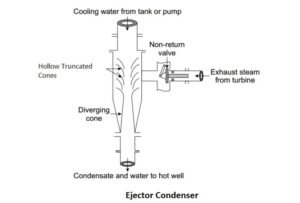 |
| Fig 7: Ejector Condenser Source: mechanicalboosterl.com |
After that, the steam and air travel through the hollow truncated cones. It then passes through the diverging cone, where some of its kinetic energy is converted to pressure energy. The hot well receives the condensate and cooling water.
Water is immediately discharged into the hot well at atmospheric pressure due to the high exit pressure in the diverging cone.
Advantages of Steam Condenser:
- The increased enthalpy drop improves the efficiency of the power plant.
- It lowers the backpressure of the steam, allowing for more work to be done.
- It permits condensate to be reused as feed water, lowering the cost of power generation.
- It lowers the temperature of the exhaust stream, allowing for more work to be done.
- The condensate has a higher temperature than the supply water. It reduces the amount of heat available per kilogram of steam.
Disadvantages of Steam Condenser:
- The initial cost is higher due to the complexity of the design.
- The surface condenser has a higher maintenance cost than others.
- Because of the large size of this type of condenser, additional floor space is required.
- Because the cooling water and condensate are discharged in the same stream, the condensate cannot be reused without water treatment.
- Direct contact condensers, such as the jet condenser, have a low vacuum efficiency.
Steam Condenser efficiency
The ratio of the temperature rise of cooling water and the difference between the vacuum temperature and inlet cooling water temperature is known as condenser efficiency.
Condenser Efficiency, hc = Temperature rise of cooling water / (Vacuum temperature – Inlet cooling temperature)
For Example, if inlet temperature of cooling water is 27°C, Outlet temperature of cooling water is 35°C, vacuum in the condenser is 70 cm of Hg with barometer reading 76 cm of Hg, what is the efficiency of condenser?
Inlet temperature of cooling water = 27°C
Inlet temperature of cooling water = 35°C
Temperature rise = 35°C – 27°C = 8°C
Vacuum in the condenser = 70 cm of Hg
Barometer reading = 76 cm of Hg
Pressure in the condenser = 76 – 70 = 6 cm of Hg = 6 x 0.0136 = 0.082 kg/cm2
From steam table, corresponding to a pressure of 0.082 kg/cm2 the vacuum temperature is 41.39°C.
Condenser Efficiency = 8/(41.39 – 27) = 55.6%
Comparison between Surface Condenser and Jet Condenser
|
Surface Condenser |
Jet Condenser |
|
1. The exhaust steam and the cooling water are not combined. |
1. Cooling water and exhaust steam combined. |
|
2. The surface condensing plant is both expensive and complex. |
2. Jet condenser allows for a simple and cost-effective condensing plant. |
|
3. Its better effective for high plants. |
3. It is less suited for high-capacity plants |
|
4. The condensate is recycled. |
4. Condensate is a waste material that cannot be recycled. |
|
5. It has a high cost of maintenance. |
5. It requires less maintenance. |
|
6. It is needed to have a huge amount of circulating water. |
6. It is needed to use less circulating water. |
|
7. The air pump in the surface condensers requires less electricity. |
7. The air pump in the jet condenser needs extra power. |
|
8. Pump water requires less energy. |
8. Pump water requires a lot of power. |
Conclusion
The steam condenser is a key component in a power plant that has a considerable impact on power generation and unit heat rate performance. Condenser thermal performance has an impact on not only energy generation but also the unit’s total thermal performance.
The heat rate of the power cycle clearly degrades with increased cooling water temperature for a given power production. Cooling water flow rate increases to maintain the same heat transfer at greater condenser vacuum to optimize condenser operation and improve power cycle heat rate.
[subscribe_to_unlock_form]


